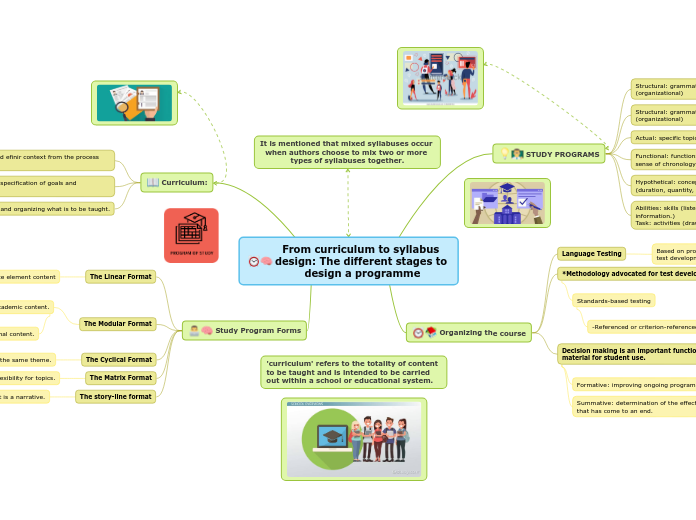From curriculum to syllabus design: The different stages to
design a programme
STUDY PROGRAMS
Structural: grammatical and phonological structures (organizational)
Structural: grammatical and phonological structures (organizational)
Actual: specific topics (health, clothing, food, etc.)
Functional: functions (inform, correct, integrate, etc.) sense of chronology and utility.
Hypothetical: conceptual categories called notions (duration, quantity, location, etc.).
Abilities: skills (listening: ideas, indifferences-seeking information.)
Task: activities (drawing, following instructions, etc.).
Organizing the course
Language Testing
Based on program goals and objectives
test development
*Methodology advocated for test development
Standards-based testing
-Referenced or criterion-referenced text tests.
Decision making is an important function as material for student use.
Formative: improving ongoing programs.
Summative: determination of the effects of a program that has come to an end.
Curriculum:
- Articulate beliefs and efinir context from the process base.
- Needs analysis and specification of goals and objectives.
-Planning and organizing what is to be taught.
Study Program Forms
The Linear Format
Is adopted for discrete element content
-Grammar
-Structures
The Modular Format
They are integrated into units of academic content.
-Thematic or situational content.
The Cyclical Format
Students and teachers work with the same theme.
The Matrix Format
Offers maximum flexibility for topics.
The story-line format
It is a narrative.
It is mentioned that mixed syllabuses occur when authors choose to mix two or more types of syllabuses together.
'curriculum' refers to the totality of content to be taught and is intended to be carried out within a school or educational system.



